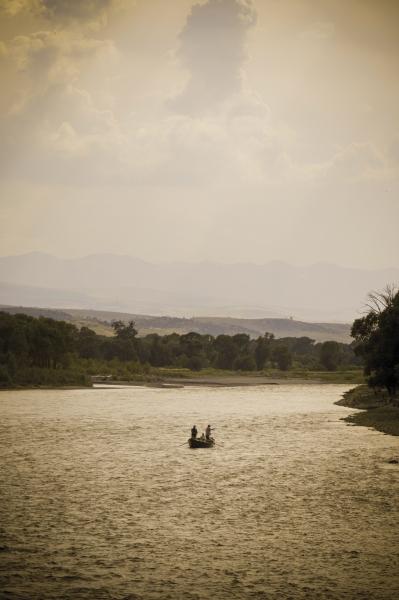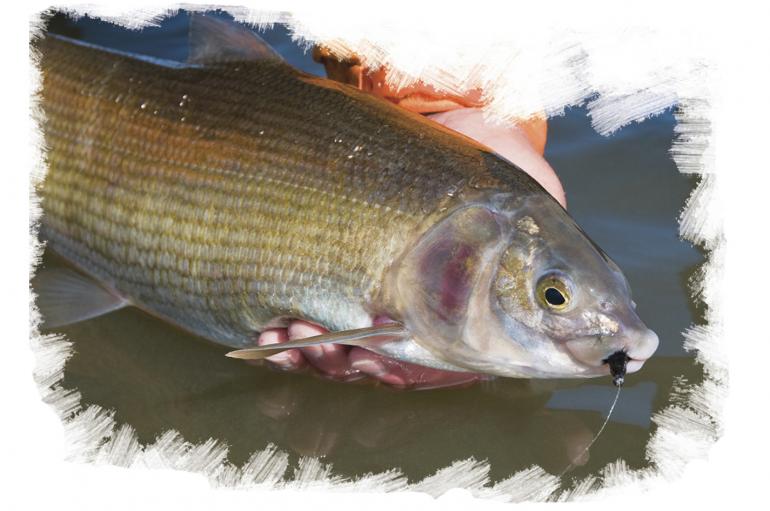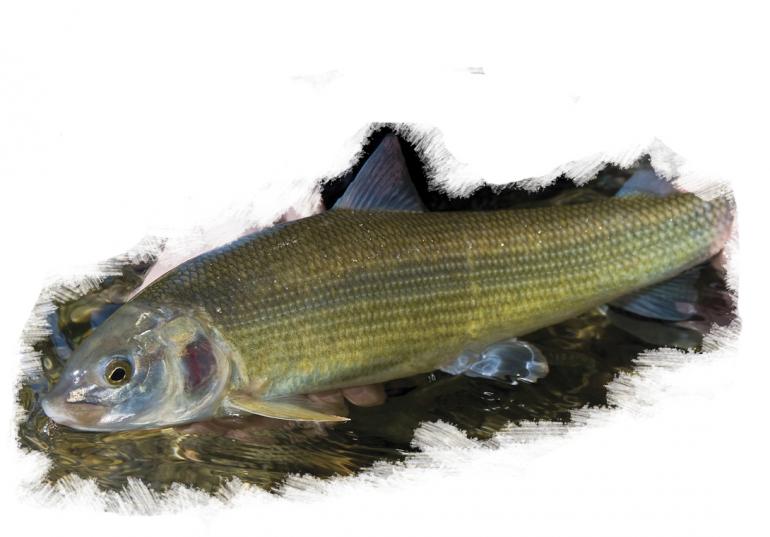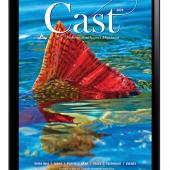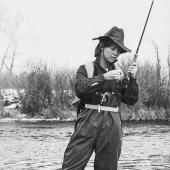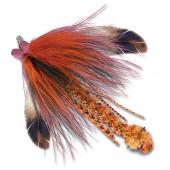Mighty Whitey
I’m not sure when I started wanting a drift boat. I do know why. On various trips around Montana, I’d drive past glimmering rivers and catch an occasional glimpse of a drift boat, anglers fore and aft, a hardy captain at the oars. It was a dream I carried for a number of years until finally, one bright spring day, I saw an advertisement in the local paper: 2001 ClackaCraft, fully equipped. The price was right and I had a buddy who also had drift-boat dreams, so we pooled our money and ended up with a fine craft. Now we were in a perfect position to catch trout after trout, to bring brawling rainbows and brawny browns to net as we floated in a Captain Morgan pose down some frothy Montana river.
The first fish on the first voyage was a whitefish.
So was the second fish. And the third. In fact, other than one brown coming off a poor winter, all the fish we caught were whitefish. While many anglers might have thought this a poor day on the water, we reckoned that we’d had a pretty fine first day, and in fact from that point on, our fine vessel became the S.S. Whitefish.
Whitefish for me have been as much a part of fishing as trout. Being a Western kid, raised on public land, tanned beneath a wide sky, I’ve always caught whitefish when I’ve been seeking trout. I’ve always caught trout when I’ve been in pursuit of whitefish. They are fine dining, smoked with hickory or mesquite; they are good fighters and they take a nymph drifted naturally in pure current; and, for me, they are a symbol of the Wild West, a pure native fish that has more business in a Montana river than do the foreigners like German browns, Eastern brookies, and Pacific Northwestern rainbows. Whitefish and cutthroat trout evolved side-by-side in Western waters.
I caught my first whitefish in my native Colorado when I was just learning to fly fish. I read Field & Stream by flashlight and I taught myself to fly cast from those articles, and also by waving around a cheap fiberglass Eagle Claw fly rod in my front lawn. The first fish I brought to net were brook trout and the next were whitefish. The latter came on the Elk River out of Steamboat Springs, Colorado, in the summer of ‘72. I was ten years old. I can still remember that fish, the clear water, the smell of streamside spruce. I ate him.
Through the years, Mr. White has saved many a fishless day. Sure, he’s drab. He’s kind of slimy. He’s got a face only a mother could love. Yet he’s likely the proverbial “canary in a coal mine” for water quality. He’s a genuine true-blue native Montanan. He’s good eating. He’s a fighter. What’s not to love?
I’ve never understood why the mountain whitefish, a coldwater game fish native to our western waters, is the object of disdain among many fishermen. It’s possible the reason comes from a widespread “take as many as you can” regulation of many game and fish agencies that still allow 50-fish limits. (Montana’s is a somewhat lower, yet still healthy, 20 per day.) Wildlife- and fisheries-management history has shown that high bag limits lead the public to a general feeling of unlimited riches.
Then there’s the open disgust that some so-called “sportsmen” on Montana rivers have shown whitefish through the years. Stories of fishermen throwing whitefish on the banks, or running objects through their gills, or giving them a firm squeeze—the so-called “Montana handshake”—before tossing them overboard are abundant. Such actions speak not only of a poor sporting ethic that amounts to poaching, but also of plain ignorance for a native species in native water and a disregard for its place in a coldwater ecosystem.
The irony of a person gently catching and releasing an exotic non-native fish such as a brown or rainbow trout yet killing and wantonly wasting a native is palpable. This is a fish that is classified as a game fish. It is not a trash fish and yet some unethical fishermen treat it as such.
Yet other people will tell you that whitefish have saved many a trout-free day on Montana rivers. Sometimes, when the trout bite is off, Mr. White is the only customer you can catch. He often fights hard and provides the same kind of sport as an equally sized trout. He can be released gently to fight another day, and he takes bait, small nymphs, the occasional dry, and once in a while even a big hopper. The latter happened one summer on the Yellowstone River when my brother came up to visit for three days of fishing. We boated many Yellowstone native cutthroats and many whitefish. It was an all-native day.
A few years ago, a friend and I drew a permit on the Smith River. The legendary Smith, and its even more legendary permit to float, is the trip of a lifetime. But the only problem was that we drew our permit in June, right in the height of spring runoff. The Smith was about the color of creamed coffee. We launched our canoe anyway, and made our way down between the ponderosa- and trophy-home-lined banks. We fished occasionally, driven by hopeful optimism, but caught nothing in the main Smith. One day, we rounded a bend where one of the river’s main tributaries dumps in. It was clear. We wandered up the clear crick, fishing hard, and caught three trout and about a dozen whitefish. The trip was saved.
These have been years of low flows and troubled water systems. The mountain whitefish, that native fish, is looking to be in serious trouble. If you have fished Montana rivers for more than a decade, ask yourself if you catch as many whitefish as you used to. Chances are the answer is no—and not by a long shot.
The anecdotal evidence of this is everywhere. On the Madison alone, guides had a hard time keeping whitefish off the hook in the ‘70s and ‘80s; now whitefish are only occasionally boated.
Mr. White appears to be in danger. Part of the reason may be drought, which is hitting not only whitefish, but also other coldwater species like our beloved trout and imperiled grayling. Another part of the equation is whirling disease. Whirling disease is carried by tubifex worms, and the parasites infect the nervous systems of young fish. The morality rate is high—about 90 percent. Now, initial findings are indicating that whitefish are very susceptible to whirling disease.
Science has a problem and it probably traces back to the widespread disrespect that the whitefish gets from the trout-hunting populace. Not very much is known about whitefish to begin with—few people have ever studied them. We do know that they are fall spawners and are not sexually mature until they are three years old. We also know that they do not compete much with our trout because they feed near the bottom while trout feed mostly on drifting insects. Where bull trout are part of the river ecosystem, juvenile whitefish are an important food source, with big bull trout snacking on young whitefish like candy. For a rare native fish like bull trout, a good consistent food source like whitefish is key to the survival of an entire species.
Regardless of whether they save your trout-free day or if they feed an important species like bull trout, there is no doubt that whitefish are part of the system that makes things work. “There is a reason they are there,” says Dave Kumlien of Trout Unlimited’s Whirling Disease Foundation. “They occupy a key ecological niche.”
So while you are out on those beautiful shimmering rivers and have been stumped by trout, don’t “diss” Mr. White. Bring him to the boat, net him gently, and release him to fight another day. I, for one, do not want to think of a world without a Western native like “Whitey.”
This story is taken from Blue Lines, published by Riverbend Publishing.


